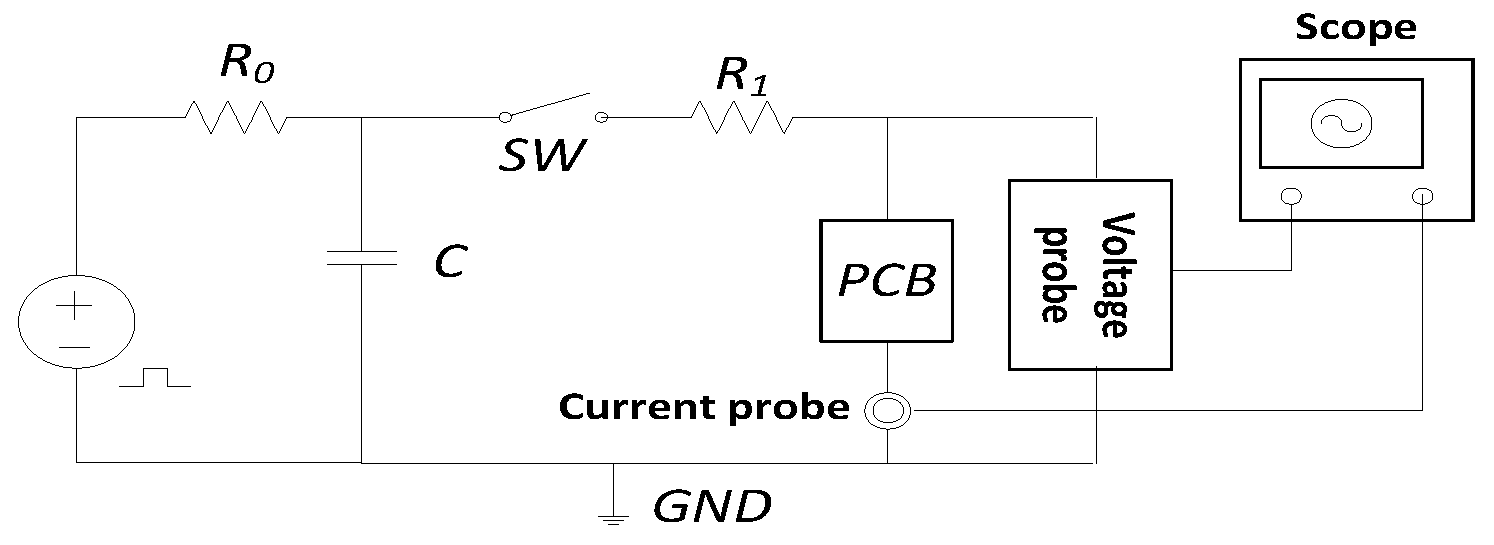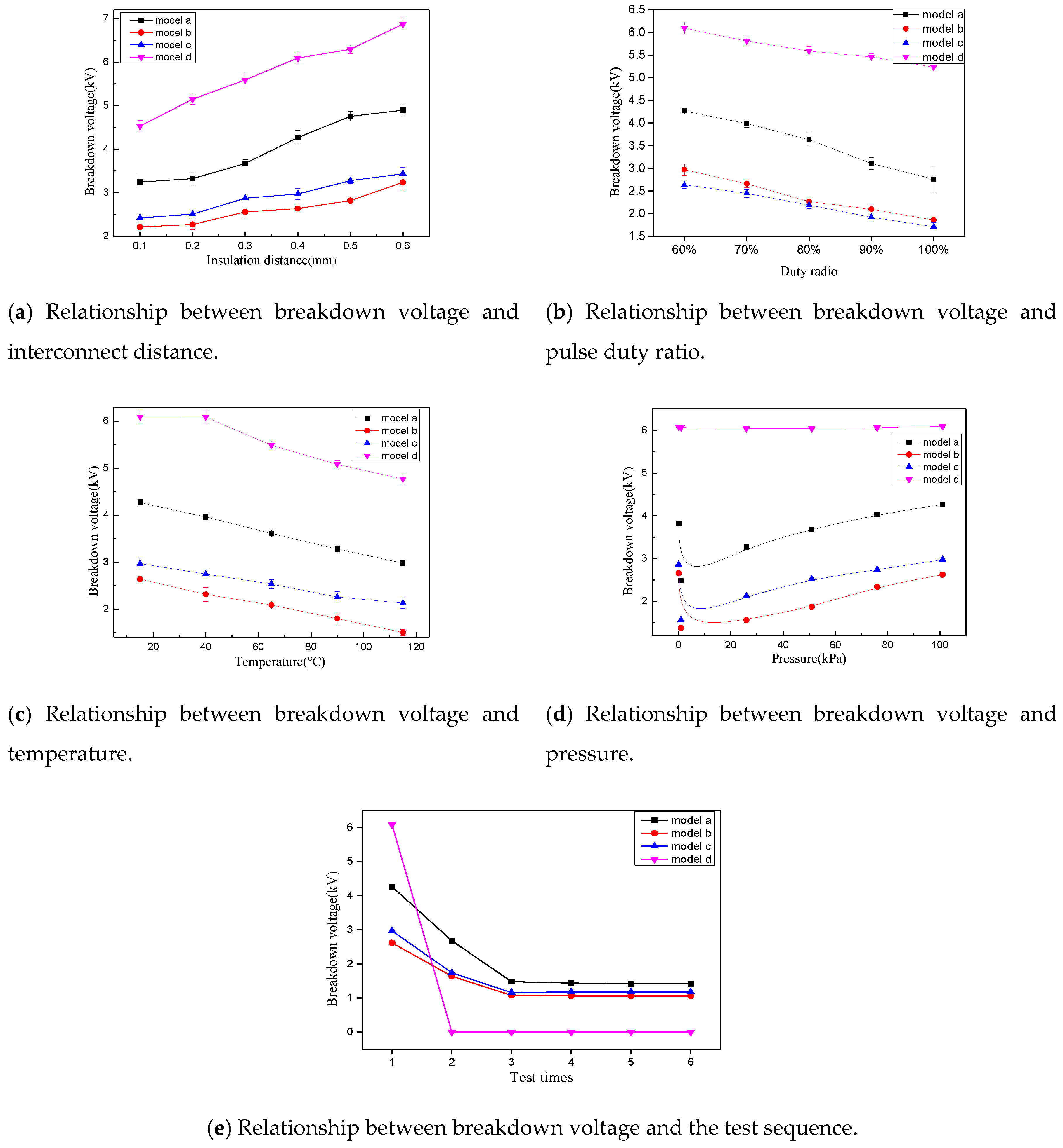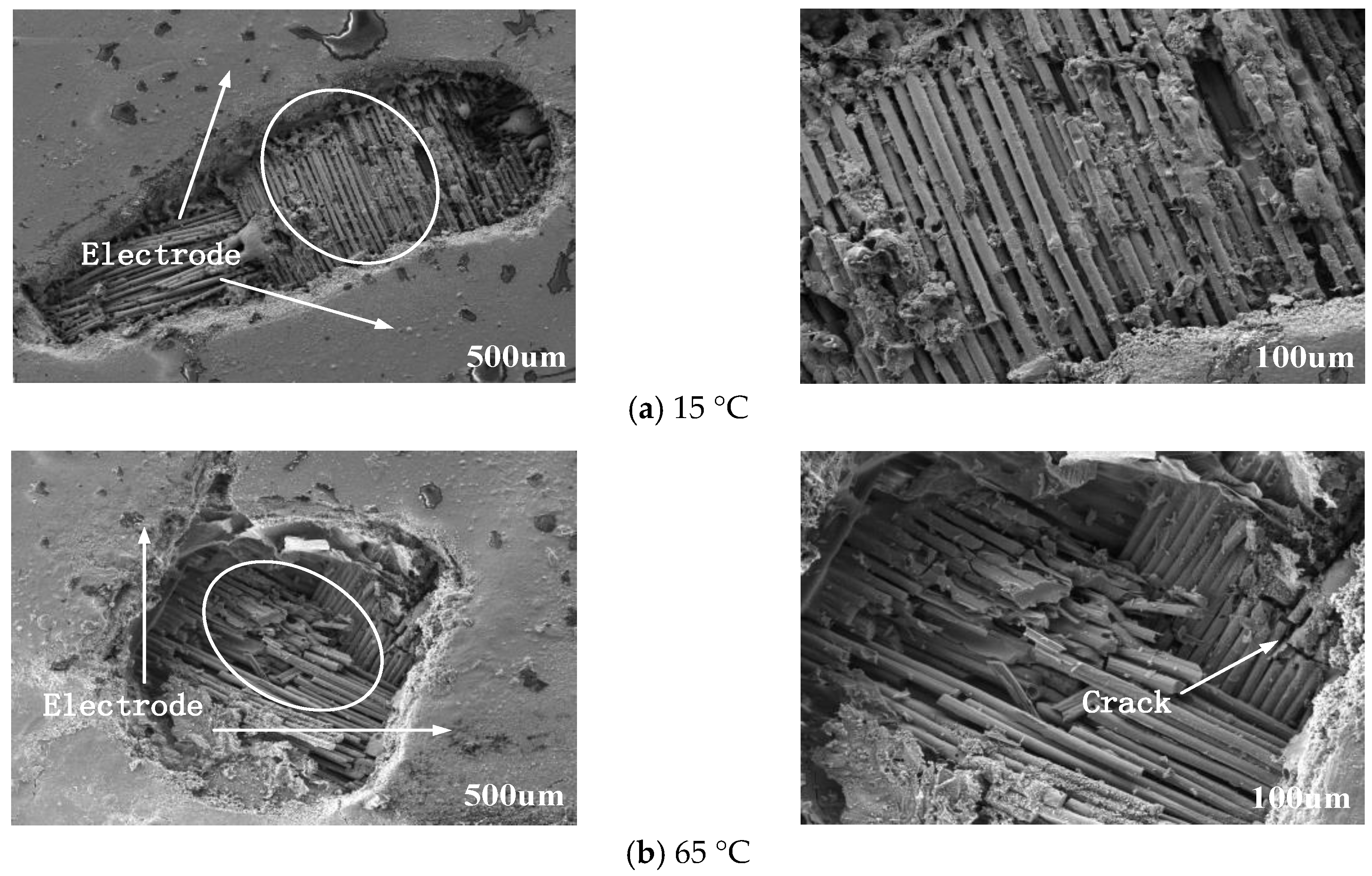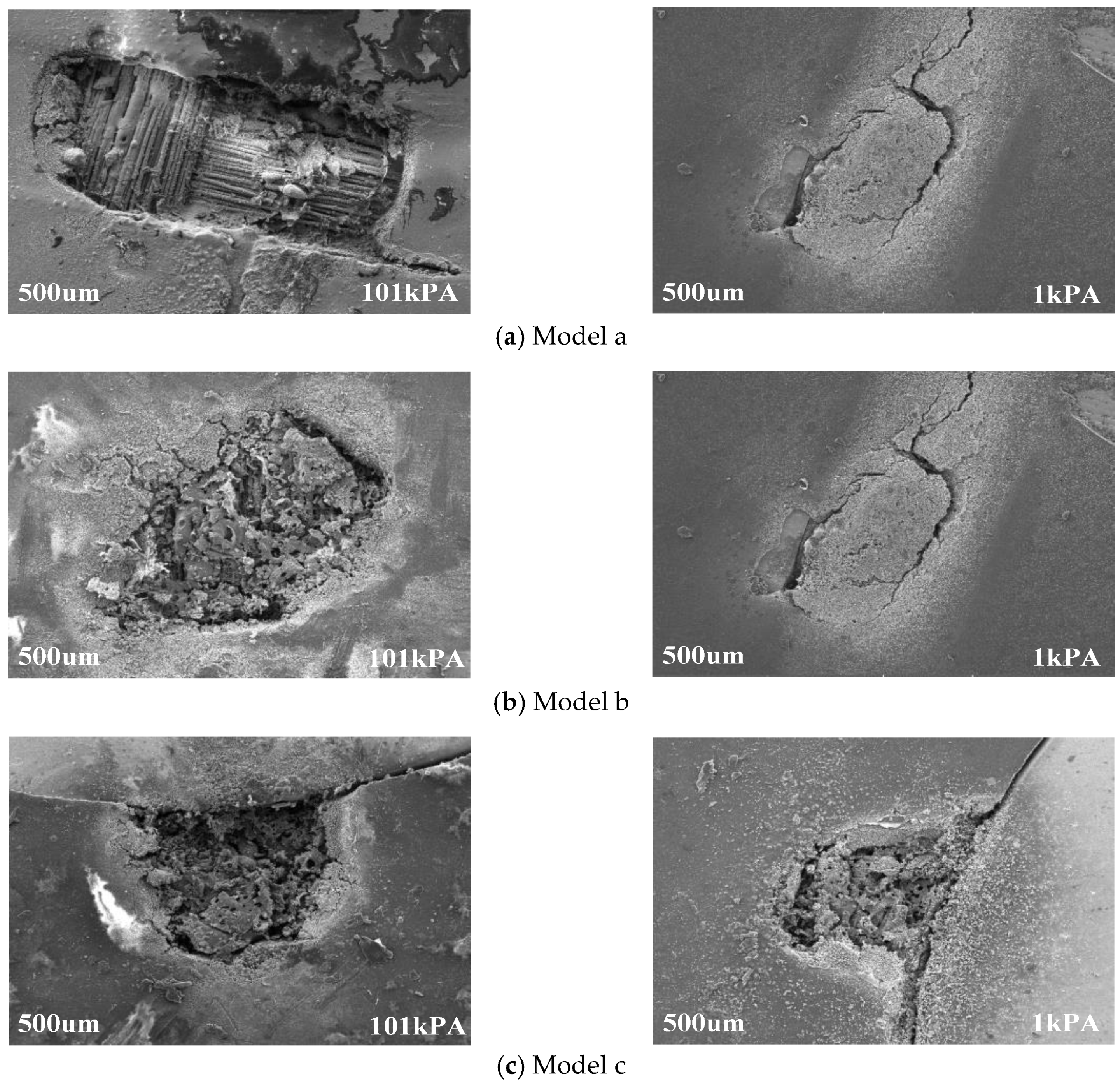Study on Insulation Breakdown Characteristics of Printed Circuit Board under Continuous Square Impulse Voltage
Abstract
:1. Introduction
2. Electrode Model Design and Simulation Analysis
3. Experimental System and Test Results
3.1. Experimental System
3.2. Experimental Result
3.2.1. Influence of Interconnect Distance on the Breakdown Voltage of the Four Models
3.2.2. Influence of Pulse Duty Ratio on the Breakdown Voltage of the Four Models
3.2.3. Influence of Temperature on the Breakdown Voltage of the Four Models
3.2.4. Influence of Air Pressure on the Breakdown Voltage of the Four Models
3.2.5. Effect of Breakdown Times on the Breakdown Voltage of the Four Models
3.3. SEM Results
3.3.1. Influence of Temperature on the Breakdown of PCB Insulation
3.3.2. Influence of Air Pressure on the Breakdown of PCB Insulation
4. Discussion and Analysis
4.1. Analysis of Experimental Results
4.2. Analysis of SEM Results
4.3. Analysis of the Formation of PCB Breakdown Carbonization Channel
5. Conclusions
- (1)
- According to the simulation analysis of the electric field, the weakest breakdown point of model (a) was at the junction of the copper foil electrode and the epoxy resin layer, and the electric field intensity between the two conductors presented a U-shaped distribution with symmetry. The weakest breakdown point of model (b) was at the vertex of the corner of the two electrodes. The electrode and pad of model (c) showed field strength distortion, but the distortion at the pad edge was more serious than that at the electrode edge. In model (d), the glass epoxy resin in the vertical area between the two electrodes was the weakest link of PCB insulation, and a large distortion of field strength occurred at the junction between the two electrode edges and the glass epoxy resin.
- (2)
- The experimental results indicated that the discharge between the single-layer electrodes of the PCB was surface discharge, as observed in models (a), (b), and (c). The breakdown was “gas–solid composite medium”, and the breakdown process was influenced by gas pressure. For models (a), (b), and (c), the breakdown performance of PCBs at different gas pressures was approximately consistent with Paschen’s curve. After the repeated breakdown of these three electrode models, the PCBs of models (a), (b), and(c) still had a certain insulation capacity. In other words, the air between two PCB electrodes also participated in the breakdown process of PCBs, which was of a “gas–solid composite medium”.
- (3)
- For model (d), the breakdown mode was solid breakdown. An inflection point emerged with the increase in temperature. Before the inflection point, the breakdown voltage was nearly unchanged by the change in temperature. After the inflection point, the breakdown voltage decreased gradually with the increase in temperature. The breakdown voltage of model (d) was almost unaffected by air pressure as well. After breakdown, it basically lost its insulation capacity and was unrecoverable.
- (4)
- The surface morphology of PCB after breakdown at different temperatures and atmospheric pressures was observed and analyzed through SEM. The position of the breakdown carbonization channel was basically consistent with the position of the simulated insulation weakness, and the two positions could be verified by each other. The results showed that the higher the temperature was, the more serious the damage on the physical structure of the PCB epoxy layer was. The carbonization channel of PCB that was subjected to breakdown at low pressure was lighter than that subjected to breakdown at normal atmospheric pressure, and the damage degree of the PCB insulation structure was small.
Author Contributions
Funding
Acknowledgments
Conflicts of Interest
References
- Leone, M. Radiated susceptibility on the printed circuit board level: Simulation and measurement. IEEE Trans. Electromagn. Compat. 2005, 47, 471–478. [Google Scholar] [CrossRef]
- Tao, J.; Chen, Y. Development of HPM Weapon for Foreign Military. Zhongguo Dianzi Kexue Yanjiuyuan Xuebao (J. China Acad. Electron. Inf. Technol.) 2011, 6, 111–116. [Google Scholar]
- Liu, S. Electrostatic Discharge and Harm Protection; Beijing University of Posts and Telecommunications Press: Beijing, China, 2005. [Google Scholar]
- Mar, M.H. Electromagnetic Pulse (EMP) Coupling Codes for Use with the Vulnerability/Lethality (V/L) Taxonomy; Technical Report for 45 Military Technology; Weaponry, and National Defense: Adelphi, MD, USA, 1995. [Google Scholar]
- Chen, J.; Liu, S.; Tan, Z. Damage Effects of Integrated Circuits Injected by Square Wave Pulse. J. Ordnance Eng. Coll. 2006, 18, 12–15. [Google Scholar]
- Chen, J.; Liu, S.; Tan, Z.; He, Q. Similarities and Differences of Damage Effects of Integrated Circuits Injected by ESD Pulse and Rectangular Pulse. High Volt. Eng. 2007, 33, 102–106. [Google Scholar]
- Du, B.X.; Gao, Y. Effect of Low Pressure and Magnetic Field on Dielectric Breakdown of Printed Circuit Board. In Proceedings of the International Symposium on Discharges and Electrical Insulation in Vacuum, Matsue, Japan, 25–29 September 2006; pp. 132–135. [Google Scholar]
- Moshrefi, T.M.; Swingler, J. Reliability of printed circuit boards containing lead-free solder in aggressive environments. J Mater. Sci. Mater. Electr. 2011, 22, 400–411. [Google Scholar] [CrossRef]
- Zhou, Y.; Lan, F. The Effects of Soluble Salts in Dust on Insulation Failure of Printed Circuit Boards. Trans. China Electr. Soc. 2016, 31, 114–119. [Google Scholar]
- Meng, G.; Cheng, Y.; Song, J.; Liu, Y.; Wu, K.; Dong, J. Breakdown characteristics of PCB paralleled traces injected by rectangular pulse. In Proceedings of the International Conference on Electrical Insulating Materials, Kyoto, Japan, 6–10 September 2011; pp. 144–147. [Google Scholar]
- Zhao, J.; Shen, G. The Design for PCB Land Responding to SMT. Electr. Process Technol. 2002, 23, 192–195. [Google Scholar]
- Meng, G.; Cheng, Y.; You, X.; Wu, K.; Liu, Y. Break-down on Interconnect System of Printed Circuit Board under Square Wave Pulse. J. Xian Jiaotong Univ. 2012, 46, 58–63. [Google Scholar]
- Li, H.; Yu, D.; Sun, W.; Liu, D.; Li, J. State-of-the-art of Atmospheric Discharge Plasmas. High Volt. Eng. 2016, 42, 3697–3727. [Google Scholar]
- Chang, W.; Yan, C.; Bi, J.; Fe, Z. Study on the Relationship between Partial Discharge Development and Electrical Tree Growth in Silicone Rubber. Proc. Csee 2014, 34, 2493–2501. [Google Scholar]
- Wang, P.; Wang, J.; Xu, H.; Zhou, K.; Lei, Y.; Zhou, Q. Comparative study of PD characteristics for inverter-fed motor insulation under sinusoidal and repetitive square wave voltage conditions. High Volt. Eng. 2016, 42, 3895–3900. [Google Scholar]
- Chao, T. The Breakdown Voltage of Power Transformer Insulation Paper after Thermal Aging. Trans. China Electr. Soc. 2010, 25, 1–8. [Google Scholar]
- Liu, T.; Han, S.; Li, Q. Patterns and Development of the Surface Discharge of High Frequency Power Transformer Insu-lation Under Frequency-Dependent Electric Stress. Trans. China Electr. Soc. 2016, 31, 199–207. [Google Scholar]
- Gao, W.; Sun, G.; Yan, P. Discussion on the Mechanism of Surface Flashover under High Vacuum. High Volt. Eng. 2005, 31, 1–4. [Google Scholar]
- Xue, Y.J.; Yin, X.S. Calculation of Low Pressure Breakdown Threshold of Microwave Devices. Space Electr. Technol. 2012, 12, 55–61. [Google Scholar]
- Zhan, H.; Yao, L.; Zhi, L.I.; Duan, S.; Cheng, L.I.; Lin, Z. Research on Repeated Breakdown Process of Disconnector Contact Gap During Very Fast Transient Overvoltage Test of Overall Switching Process of Disconnector in 252 kV GIS. Power Syst. Technol. 2014, 38, 2570–2574. [Google Scholar]










| Characteristic | Unit | Typical Value |
|---|---|---|
| Glass Transition Temperature | °C | 132.9/1.3 |
| Volume Resistivity | MΩ-cm | 1.39 × 1010 |
| Surface Resistivity | MΩ | 2.25 × 109 |
| Dielectric Constant | 4.6 | |
| Arc Resistance | S | 120 |
© 2018 by the authors. Licensee MDPI, Basel, Switzerland. This article is an open access article distributed under the terms and conditions of the Creative Commons Attribution (CC BY) license (http://creativecommons.org/licenses/by/4.0/).
Share and Cite
Zhou, Q.; Wen, M.; Xiong, T.; Jiang, T.; Zhou, M.; Ouyang, X.; Xing, L. Study on Insulation Breakdown Characteristics of Printed Circuit Board under Continuous Square Impulse Voltage. Energies 2018, 11, 2908. https://doi.org/10.3390/en11112908
Zhou Q, Wen M, Xiong T, Jiang T, Zhou M, Ouyang X, Xing L. Study on Insulation Breakdown Characteristics of Printed Circuit Board under Continuous Square Impulse Voltage. Energies. 2018; 11(11):2908. https://doi.org/10.3390/en11112908
Chicago/Turabian StyleZhou, Quan, Mingqian Wen, Taotao Xiong, Tianyan Jiang, Ming Zhou, Xi Ouyang, and Lai Xing. 2018. "Study on Insulation Breakdown Characteristics of Printed Circuit Board under Continuous Square Impulse Voltage" Energies 11, no. 11: 2908. https://doi.org/10.3390/en11112908
APA StyleZhou, Q., Wen, M., Xiong, T., Jiang, T., Zhou, M., Ouyang, X., & Xing, L. (2018). Study on Insulation Breakdown Characteristics of Printed Circuit Board under Continuous Square Impulse Voltage. Energies, 11(11), 2908. https://doi.org/10.3390/en11112908





